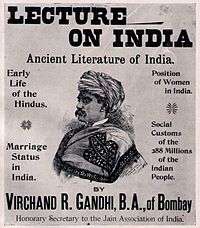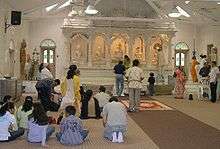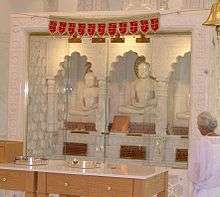Jainism in the United States
| Total population | |
|---|---|
| 150,000[1][2] | |
| Languages | |
|
American English Indian Languages | |
| Religion | |
| Jainism |
| Part of a series on |
| Jainism |
|---|
 |
|
Jain prayers |
|
Ethics |
|
Major sects |
|
Festivals |
|
|
Adherents of Jainism first arrived in the United States in the 20th century. The most significant time of Jain immigration was in the early 1970s.
History

In 1893, Virachand Gandhi was officially the first Jain delegate to visit the United States, and represented Jainism in the first ever Parliament of World Religions.[3] Virchand Gandhi is considered a key figure in the history of American Jainism as the first practicing Jain to speak publicly in the United States about Jainism.[1] The first St. Louis Jain temple in the United States was built for the St. Louis World's Fair in 1904. After the fair, the temple was moved to Las Vegas and later to Los Angeles. It is now owned by the Jain Center of Southern California. Adherents of Jainism first arrived in the United States in 1944.[4] The most significant time of Jain immigration was in the early 1970s. The United States has since become a center of the Jain diaspora .

The first former Jain monastic to travel to the United States, Chitrabhanu, arrived in 1971. He gave several lectures about Jainism at Harvard University and established a Jain center in New York City. The first monk who traveled outside India by use of mechanical means was Acharya Sushil Kumar who arrived in the United States in 1975.[5] He established multiple Jain centers, including International Mahavira Jain Mission popularly known as Siddhachalam.[6] In the 1980s, he and Chitrabhanu inspired the founding of Federation of Jain Associations in North America to support the Jain community in the United States and Canada.[6]
As of 2010 the United States contained the most Jain temples of any country in the Jain diaspora.[1] At least one third of the Jains living outside India live in the United States, numbering close to 100,000.[1][2] Jain temples in the United States, which numbered 26 as of 2006, frequently incorporate marble and arches in a style reminiscent of Rajasthan architecture.[1] There are almost 100 distinct Jain congregations in the United States.[6]
Many Jains in the United States are often employed in white-collar occupations. They also frequently volunteer at animal welfare organizations.[1]
Jain Sects
Unlike India and United Kingdom, the jain community in United States doesn’t find sectarian differences, Both digambara and swetambar Śvētāmbara share common roof. Although swetambara sect in united states claims to represent all jains by Cultural Appropriation as they are in majority (76% vs 24%) with various non-denominational Jain temples, which, in reality are run as Śvētāmbara temples with very little or no management participation of digambara.
Federation of Jain Associations in North America and Siddhachalam

The Federation of Jain Associations in North America is an umbrella organization of local American and Canadian Jain congregations to preserve, practice, and promote Jainism and the Jain way of life.[7] Siddhachalam located in Blairstown, NJ, is the first place of pilgrimage for Jains outside India. It is a sister organization of Jaina and brings together all Jains into one place for worship, study and reflection.[8]
Jain symbols
The Federation of Jain Associations in North America uses a modified version of the standard Jain symbol, the Jain Emblem. It replaces the swastika with an om because the former is not considered a pious symbol in the western world.[9]
Jain Studies
Florida International University (Miami, Florida) hosts the Bhagwan Mahavir Professorship in Jain Studies, the first Jain Studies chair at a North American university. The Jain Society and Rice University signed a memorandum of understanding in January 2016 to establish a post-doctoral fellowship in Jain studies.[10]
American Jain Centers
Most of the Jain centers are complexes that include a main temple that houses both Shvetambara and Digambara images, libraries, meeting rooms, room for visiting monks/nuns etc.
- Siddhachalam, New Jersey
- Jain Center of Southern California, Buena Park, California
- St. Louis Jain temple
- Jain Center of America
- Jain Center of Greater Phoenix
- Siddhayatan
- Jain center of Northern California, Milpitas, California
- Jain Center of Connecticut, Connecticut
- Jain Sangh of New England, Burlington, Massachusetts
- Jain Society of Chicago, Illinois
- Jain Society of Greater Atlanta
- Redmond Jain Derasar, Redmond, Washington
- Jain Society of Seattle
- Jain Center of Washington
- Jain Society of Greater Cleveland
- Jain religion center of Wisconsin
- Jain Temple of Greater Detroit - Farmington Hills, Michigan
- Franklin Township Derasar, New Jersey
- Jain Society of Metropolitan Chicago
- Jain Temple of Pennsauken Township (Cherry Hill), New Jersey
- Jain Vishwa Bharti - NEW JERSEY. ORLANDO HOUSTON - Swetamber Terapanthi stanak- jvbnewjersey.org
- Jain Society of Tampa Bay, Tampa
Gallery
 Hindu Jain temple in Monroeville, Pennsylvania
Hindu Jain temple in Monroeville, Pennsylvania Greater Baltimore Hindu-Jain Temple
Greater Baltimore Hindu-Jain Temple Main shrine at Siddhachalam Jain center, New Jersey
Main shrine at Siddhachalam Jain center, New Jersey Jain Center of America in New York City with images of Tirthankaras.
Jain Center of America in New York City with images of Tirthankaras..jpg) Manastambha at Jain Center of Greater Phoenix (JCGP)
Manastambha at Jain Center of Greater Phoenix (JCGP).png) Rishabhantha idol at Jain Center of Greater Phoenix (JCGP)
Rishabhantha idol at Jain Center of Greater Phoenix (JCGP).png) Mahavira idol at Jain Center of Greater Phoenix (JCGP)
Mahavira idol at Jain Center of Greater Phoenix (JCGP) Lord Adinatha at Franklin Township derasar
Lord Adinatha at Franklin Township derasar Main vedi at Franklin Township derasar
Main vedi at Franklin Township derasar Idol of Goddess at Franklin Township derasar
Idol of Goddess at Franklin Township derasar Namokar Mantra at Terapanti shrine of Franklin Township derasar
Namokar Mantra at Terapanti shrine of Franklin Township derasar
See also
References
- 1 2 3 4 5 6 Lee, Jonathan H. X. (21 December 2010), Encyclopedia of Asian American Folklore and Folklife, ABC-CLIO, pp. 487–488, ISBN 978-0-313-35066-5
- 1 2 Wiley, Kristi L. (2004), Historical dictionary of Jainism, Scarecrow Press, p. 19, ISBN 978-0-8108-5051-4
- ↑ Jain, Pankaz; Pankaz Hingarh; Dr. Bipin Doshi, Priti Shah. "Virchand Gandhi, A Gandhi Before Gandhi". A german e-magazine. herenow4u.
- ↑ Watts, Tim J. "Religion, Indian American". In Huping Ling; Allan W. Austin (17 March 2015). Asian American History and Culture: An Encyclopedia. Routledge. p. 353. ISBN 978-1-317-47645-0.
- ↑ The Gurus of India, Uban, SS., Allied Publishers, 1977. https://books.google.com/books?id=8dvGJjBHXYsC&pg=PA79&lpg=PA79&dq=Jain+monk+travel+sushil&source=bl&ots=b-vEc78VI7&sig=zZRiP56zp0UOKYyS33teEGPNsag&hl=en&sa=X&ved=0ahUKEwix-4jYh7HVAhXDWT4KHSdNAG8Q6AEIYTAP#v=onepage&q=Jain%20monk%20travel%20sushil&f=false
- 1 2 3 Queen, Edward L.; Prothero, Stephen R.; Shattuck, Gardiner H. (2009), Encyclopedia of American religious history, Infobase Publishing, p. 531, ISBN 978-0-8160-6660-5
- ↑ "About JAINA". Retrieved 2012-01-16.
- ↑ "About Siddhachalam". Siddhachalam. 28 June 2013. Retrieved 2017-10-26.
- ↑ "Jain Symbols". p. 29. Retrieved 2012-03-16.
- ↑ "US' Rice University to offer post-doctoral fellowship in Jain studies", The Economic Times, 25 January 2016
Further reading
- Jainism in America Bhuvanendra Kumar. Benaras, Jain Humanities Press, 1996
- The Western Order of Jainism by Nathubhai Shah of London (Jain Journal Vol XXX1, No 1 July 1996)
- Jains and Their Religion in America: A Social Survey by Dr. Bhuvannendra Kumar (Jain Journal Vol XXX1, No 1 July 1996)
- JAIN eLibrary attempts to provide an increasingly complete digitized collection of Jain Scriptures, dictionaries, encyclopedias, articles, commentaries, photographs, and other materials related to Jain life.
.jpg)